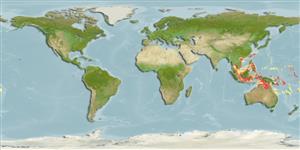>
Perciformes/Scorpaenoidei (Scorpionfishes) >
Aploactinidae (Velvetfishes)
Etymology: Xenaploactis: Greek, xenos = strange + Greek, aplos = double + Greek, aktis, -inos = ray (Ref. 45335); cautes: Name means a rough, pointed rock [= cautes]. Noun in apposition.
Environment: milieu / climate zone / depth range / distribution range
Ökologie
seewasser demersal; tiefenbereich 33 - 79 m (Ref. 35984). Tropical
Indo-western Pacific: Gulf of Thailand.
Size / Gewicht / Alter
Maturity: Lm ? range ? - ? cm
Max length : 2.8 cm SL Männchen/unbestimmt; (Ref. 35984)
Rückenflossenstacheln (insgesamt) : 14; Rückenflossenweichstrahlen (insgesamt) : 8 - 9; Afterflossenstacheln: 1; Afterflossenweichstrahlen: 10; Wirbelzahl: 27 - 28. Body densely covered with modified scales which form spinous points; depth less than 1/3 SL.. Lachrymal with 3 strong sharp spines, the first of moderate size , points mostly forward, continuous with ridge at base of larger 2nd spine (about equal in length to 3rd), directed downward, slightly curved; 3rd spine points mostly back. Second infraorbital bone with 2 spines, 1 above other, with obscure circular lateral line pore. Interorbit with nearly parallel ridges, stronger posteriorly (Ref. 35984, 39602).
Occurs on soft bottom. Benthic (Ref. 75154).
Life cycle and mating behavior
Geschlechtsreife | Fortpflanzung | Ablaichen | Eier | Fecundity | Larven
Poss, S.G. and W.N. Eschmeyer, 1980. Xenaploactis, a new genus for Prosopodasys asperrimus Günther (Pisces: Aploactinidae), with descriptions of two new species. Proc. Calif. Acad. Sci. 42(8):287-293. (Ref. 35984)
IUCN Rote Liste Status (Ref. 130435: Version 2024-2)
Bedrohung für Menschen
Harmless
Nutzung durch Menschen
Tools
Zusatzinformationen
Download XML
Internet Quellen
Estimates based on models
Preferred temperature (Ref.
123201): 26.1 - 28.6, mean 27.5 °C (based on 267 cells).
Phylogenetic diversity index (Ref.
82804): PD
50 = 0.6250 [Uniqueness, from 0.5 = low to 2.0 = high].
Bayesian length-weight: a=0.01288 (0.00419 - 0.03963), b=3.03 (2.77 - 3.29), in cm total length, based on LWR estimates for this (Sub)family-body shape (Ref.
93245).
Trophic level (Ref.
69278): 3.1 ±0.3 se; based on size and trophs of closest relatives
Fishing Vulnerability (Ref.
59153): Low vulnerability (10 of 100).
